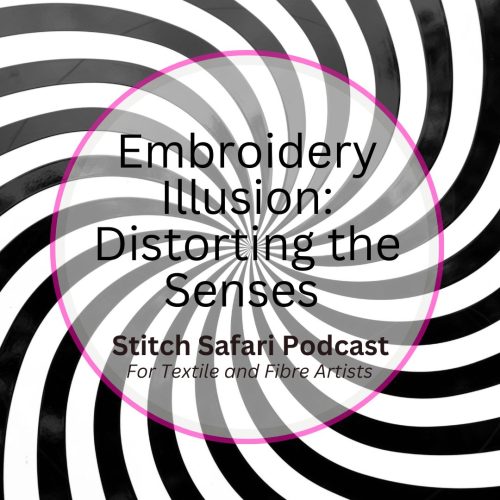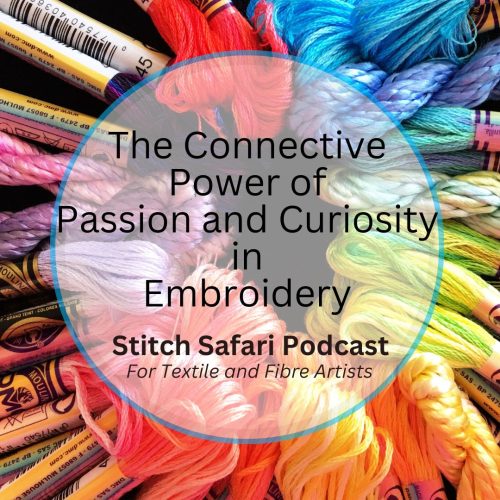To move forward with our work we need to exercise all the areas of artistic life that many don’t think about and even more, don’t or won’t acknowledge.
But these reliable, dependable, and all-so-necessary areas are there, because if we don’t work with them, we certainly won’t progress, nor will we sustain growth in our work.
The curious thing is people rarely talk about them, write about them or try to understand their importance.
In this episode of Stitch Safari, I will talk about them because, in my opinion, they’re pure gold – they’re the backbone of a successful artistic practice and should be held up and admired daily.
Everyone sees the work, the success or indeed the failure behind each piece of art, but I want to talk about all the things people don’t see – and when openly acknowledged and worked on daily, these things can make a huge difference to our work practice, success, output and even our way of thinking and approaches to daily creativity.
I want to make people think – it’s not always about what you see.
And if that’s the case – what is it about?
Have you heard of the Iceberg Effect?
90% of an iceberg is hidden underwater, meaning what we see above the waterline is only 10% of its entire size.
This analogy is so visual and easy to remember – think about a beautiful, large iceberg – we’re seeing only 1/10 of its totality.
Now equate that 1/10 or 10% as our work that people see – where’s the other 9/10 or 90%?
It’s unseen – just like that beautiful submerged iceberg.
So what on earth makes up this unseen, rarely-spoken-about, yet hugely influential 90% – things like:
- Discipline
- Routine
- Problem-solving
- Courage
- Determination
- Good Habits
- Dedication
- Passion
- Risk-taking
- Rejection
- Disappointment
- Hard work
- Momentum
- Consistency
- Values
So 90% of our artistic practice is unseen and unsung – but pure gold to those who know and understand their importance and are willing to harness their power.
In all things, there is a process.
We should be thoughtfully and mindfully incorporating these actions into our daily artistic practice from day 1 if we wish to climb that slippery slope of success because these are the methods and procedures that sustain an artist more than any other – all are unseen, all are of huge importance and work together and garner considerable power in our ability to become successful.
But when have you heard anyone talk about these approaches and procedures?
When has anyone suggested you exercise any one of these to strengthen your artistic practice?
And when has anyone suggested that you adopt these actions to create systems to guide you daily?
I am. Today. Now. Immediately.
So take some time – we are visual artists but unfortunately, the visuals have taken over.
Let those visuals go for a time and think about these things:
- How do you like to work?
- Do you make systems work for you?
- What sustains your work practice?
- What is your process?
- Do you have systems set up to support that process?
- How do you sustain momentum?
- What do you do when you finish work?
Those gem-like qualities are behind these questions – discipline, routine, problem-solving, momentum, etc.
So these concepts and approaches to our work are at the very base of our work pyramid and if we don’t have them as our support network, what on earth is our work based on?
Quicksand would be my answer.
When I began to appreciate their importance, and when I began to understand this notion that they were the true generators of power and procedure, actions and even exercise, yes, exercise, because to utilise something like discipline or to set up good habits and healthy routines, is exercising our inner-self – and that can be gruelling, let me tell you – was the moment I began to understand myself as an artist.
Off came those hidden layers we sometimes hide behind to expose the truth of us, the person, the creator, the innovator and even the spiritual guide – now that was surprising to me – but I remember embracing that I do have these abilities within me, that I can improve my work through diligence, that motivation can come not only from inspiration but from momentum and consistency of doing, trying, and thinking, that setting up healthy habits and good routines suited to me, actually helped support my work too.
Forget all the visual enticements for just a few moments and think about what’s behind all your work – what do you need daily to not only create that work but to continue to create that work and sustain it into the future?
We can continue to shimmer and shine as long as we continue to innovate and grow but we need these supports to garner that consistency, dedication and motivation.
And that’s the perfect segue into my next amazing resource – would you believe it’s a book my husband brought back from a business conference?
I thought ‘Why on earth are you giving me this to read’? But read it I did – and it immediately tapped into my way of thinking, so much so I believe I read it from cover to cover in a day – it is a very easy-to-read book.
And it made complete and utter sense to me.
I would list this as one of my top 5 favourite books, yet it has nothing to do with stitching, textiles, art or design.
It’s about building Momentum.
The book, called, surprise, surprise ‘Momentum – How to Build It, Keep It or Get It Back’, by Australian author, Michael McQueen, was first published in 2016 by John Wiley & Sons Australia, Ltd.
I recommend this book to those who wish to understand the importance of never stopping or giving up as a means of attaining success – and as I said earlier it’s relatable to the world of embroidery and textiles.
Numerous times I’ve heard people say ‘I’ve lost my mojo’ or ‘The spark is gone’ – this book suggests how to retrieve that lost mojo, sustain it and never get in that situation again.
And it makes sense.
Here are a few thought-provoking quotes from the book’s preface:
‘Objects at rest tend to stay at rest and objects in motion tend to stay in motion’.
‘A wise person learns from their mistakes; a much wiser person learns from someone else’s’.
‘Interestingly, the dynamics of long-term success at play in organisations and institutions are much the same at an individual level too’.
‘Rather, the common denominator among all uncommonly successful people comes down to one thing; just like enduring organisations, these individuals have figured out how to master the art of momentum. They have knowingly or unknowingly learned how to harness the natural rhythms of life and get them working on their side.’
This book should be dedicated reading for any aspiring artist who wants success and needs to understand how to attain and sustain it.
The book also comes with apt quotations scattered throughout:
DO NOT BE AFRAID OF GOING SLOWLY; BE AFRAID ONLY OF STANDING STILL. Chinese Proverb
THE SECRET TO GETTING AHEAD IS GETTING STARTED. Mark Twain
IF YOU CHASE TWO RABBITS, YOU WILL CATCH NEITHER ONE. Russian proverb.
NEVER CONFUSE ACTION WITH ACTIVITY. Benjamin Franklin.
Learn to be your guide and set up systems and routines to suit you and how you work best.
Read McQueen’s book, Momentum and learn the importance of never stopping because momentum is an act that needs to be mastered and controlled and you’re the one in the driver’s seat.
I wish you safe travels in your artistic journey – and huge success.





